Specialty urology OMIM 124100 MeSH D001449 | ICD-10 N15.0 DiseasesDB 31409 | |
 | ||
Balkan endemic nephropathy — also called Danubian endemic familial nephropathy (DEFN) — is a form of interstitial nephritis. It was first identified in the 1920s among several small, discrete communities along the Danube River and its major tributaries, in the modern countries of Croatia, Bosnia and Herzegovina, Serbia, Romania and Bulgaria.
Contents
History
The first official published description of the disease was made by the Bulgarian nephrologist Dr.Yoto Tanchev (1917–2000) and his team in 1956 in the Bulgarian Journal Savremenna Medizina, a priority generally acknowledged by the international nephrological community. Their study was based on a wide screening of inhabitants of the villages around the town of Vratsa, Bulgaria. Their contribution to the understanding of this unusual endemic disease of the kidneys was their description of symptoms which were not typical of common chronic nephritis, i.e., incidence only in adults (no children affected), absence of high blood pressure, xanthochromia of palms and soles (Tanchev's sign), early hypochromic anemia, absence of proteinuria, and slow progression of kidney failure.
A striking feature of the disease is its very localized occurrence. There are approximately ten small areas where it occurs, all of them more or less rural, but nothing seems to connect those areas other than the occurrence of this illness. Tanchev and colleagues suggested that the condition was sui generis. Their initial tentative hypothesis for its cause was intoxication with heavy metals, because the affected villages were supplied with water coming from nearby Vratsa Mountain, a karst-type mountain.
The disease was originally called "Vratsa nephritis," and became known as "Balkan endemic nephropathy" later, after people living in Yugoslavia and Romania were found to be suffering from it as well. But in Bulgaria and in neighbouring countries, the condition is known as "Tanchev's Nephropathy", in homage to Dr. Tanchev's work.
Symptoms and prognosis
The disease primarily affects people age 30 to 60 years of age. People moving to endemic areas do not develop the condition until living there for 15 years.
It can cause the kidneys to fail (end-stage renal disease, or ESRD) forcing a patient to start dialysis or receive a kidney transplant. In endemic areas BEN is responsible for up to 70% of ESRD. At least 25,000 individuals are known to have the disease.
Symptoms include weakness, anemia, and a coppery skin discoloration
A later finding, usually after kidney failure occurs, is transitional cancer of urothelial tract. While most urothelial cancer is in the bladder, BEN has an increased rate of the upper tract (renal pelvis and ureters).
Causes
The etiology of DEFN is not certain, although chronic exposure to dietary aristolochic acid has been identified as a major risk factor for DEFN and other, related disorders.
In the Balkan region, dietary aristolochic acid exposure may come from the consumption of the seeds of Aristolochia clematitis (European birthwort), a plant native to the endemic region, which are thought to comingle with the wheat used for bread. This theory has recently been further supported by the research of cancer biologist Arthur P. Grollman, director of the chemical biology lab at Stony Brook University in New York, and his colleague Bojan Jelaković, an associate professor at the Zagreb University School of Medicine. Aristolochic-acid-containing herbal remedies used in traditional Chinese medicine are associated with a related—possibly identical—condition known as "Chinese herbs nephropathy". Exposure to aristolochic acid is associated with a high incidence of uroepithelial tumorigenesis.
